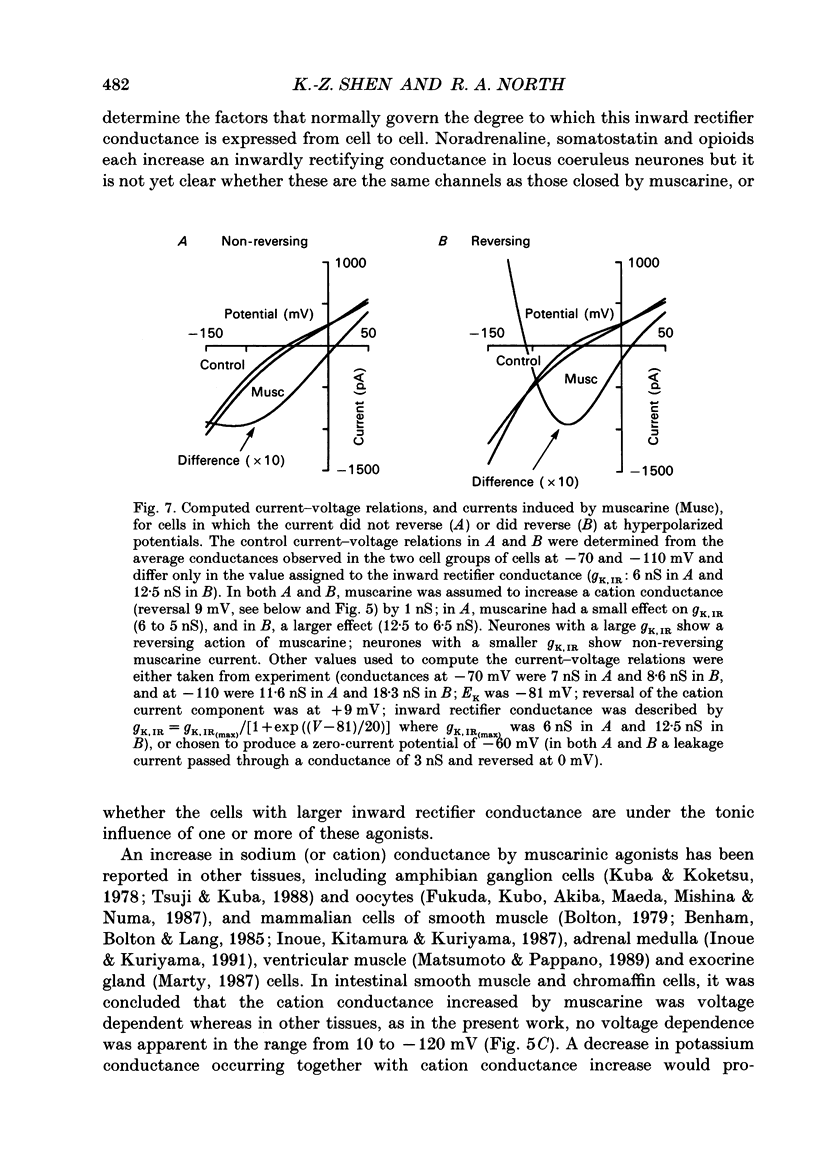Abstract
1. Whole-cell patch-clamp recordings were made from rat locus coeruleus neurones in slices of brain tissue in vitro. Muscarine (30 microM) caused an inward current of about 100 pA in neurones voltage clamped at -60 mV. 2. In about 75% of cells, the current elicited by muscarine was independent of potential in the range -60 to -120 mV and had no associated conductance change. 3. In about 25% of cells, the current became smaller with hyperpolarization, was associated with a decreased conductance, and reversed polarity between -100 and -140 mV. The reversal potential changed with the logarithm of the extracellular potassium concentration. Barium and caesium blocked inward rectification and also prevented reversal of the muscarine current. 4. When potassium ions of the intracellular and extracellular solutions were replaced by caesium, the current evoked by muscarine became smaller with depolarization at reversed polarity at +9 mV. This current was associated with an increase in conductance, and was greatly reduced when the extracellular sodium concentration was reduced to 20 mM. 5. The results could be quantitatively accounted for by a model in which muscarine both increases a voltage-independent cation conductance and decreases the inward rectifier potassium conductance.
Full text
PDF














Selected References
These references are in PubMed. This may not be the complete list of references from this article.
- Benham C. D., Bolton T. B., Lang R. J. Acetylcholine activates an inward current in single mammalian smooth muscle cells. Nature. 1985 Jul 25;316(6026):345–347. doi: 10.1038/316345a0. [DOI] [PubMed] [Google Scholar]
- Bolton T. B. Mechanisms of action of transmitters and other substances on smooth muscle. Physiol Rev. 1979 Jul;59(3):606–718. doi: 10.1152/physrev.1979.59.3.606. [DOI] [PubMed] [Google Scholar]
- Cassell J. F., McLachlan E. M. Muscarinic agonists block five different potassium conductances in guinea-pig sympathetic neurones. Br J Pharmacol. 1987 Jun;91(2):259–261. doi: 10.1111/j.1476-5381.1987.tb10279.x. [DOI] [PMC free article] [PubMed] [Google Scholar]
- Dutar P., Nicoll R. A. Classification of muscarinic responses in hippocampus in terms of receptor subtypes and second-messenger systems: electrophysiological studies in vitro. J Neurosci. 1988 Nov;8(11):4214–4224. doi: 10.1523/JNEUROSCI.08-11-04214.1988. [DOI] [PMC free article] [PubMed] [Google Scholar]
- Egan T. M., North R. A. Acetylcholine acts on m2-muscarinic receptors to excite rat locus coeruleus neurones. Br J Pharmacol. 1985 Aug;85(4):733–735. doi: 10.1111/j.1476-5381.1985.tb11070.x. [DOI] [PMC free article] [PubMed] [Google Scholar]
- Egan T. M., North R. A. Actions of acetylcholine and nicotine on rat locus coeruleus neurons in vitro. Neuroscience. 1986 Oct;19(2):565–571. doi: 10.1016/0306-4522(86)90281-2. [DOI] [PubMed] [Google Scholar]
- Fukuda K., Kubo T., Akiba I., Maeda A., Mishina M., Numa S. Molecular distinction between muscarinic acetylcholine receptor subtypes. Nature. 1987 Jun 18;327(6123):623–625. doi: 10.1038/327623a0. [DOI] [PubMed] [Google Scholar]
- Guyenet P. G., Aghajanian G. K. ACh, substance P and met-enkephalin in the locus coeruleus: pharmacological evidence for independent sites of action. Eur J Pharmacol. 1979 Feb 1;53(4):319–328. doi: 10.1016/0014-2999(79)90455-2. [DOI] [PubMed] [Google Scholar]
- Inoue M., Kuriyama H. Muscarinic receptor is coupled with a cation channel through a GTP-binding protein in guinea-pig chromaffin cells. J Physiol. 1991 May;436:511–529. doi: 10.1113/jphysiol.1991.sp018564. [DOI] [PMC free article] [PubMed] [Google Scholar]
- Inoue M., Nakajima S., Nakajima Y. Somatostatin induces an inward rectification in rat locus coeruleus neurones through a pertussis toxin-sensitive mechanism. J Physiol. 1988 Dec;407:177–198. doi: 10.1113/jphysiol.1988.sp017409. [DOI] [PMC free article] [PubMed] [Google Scholar]
- Inoue R., Kitamura K., Kuriyama H. Acetylcholine activates single sodium channels in smooth muscle cells. Pflugers Arch. 1987 Sep;410(1-2):69–74. doi: 10.1007/BF00581898. [DOI] [PubMed] [Google Scholar]
- Krnjević K., Pumain R., Renaud L. The mechanism of excitation by acetylcholine in the cerebral cortex. J Physiol. 1971 May;215(1):247–268. doi: 10.1113/jphysiol.1971.sp009467. [DOI] [PMC free article] [PubMed] [Google Scholar]
- Kuba K., Koketsu K. Synaptic events in sympathetic ganglia. Prog Neurobiol. 1978;11(2):77–169. doi: 10.1016/0301-0082(78)90010-2. [DOI] [PubMed] [Google Scholar]
- Matsumoto K., Pappano A. J. Carbachol activates a novel sodium current in isolated guinea pig ventricular myocytes via M2 muscarinic receptors. Mol Pharmacol. 1991 Mar;39(3):359–363. [PubMed] [Google Scholar]
- Matsumoto K., Pappano A. J. Sodium-dependent membrane current induced by carbachol in single guinea-pig ventricular myocytes. J Physiol. 1989 Aug;415:487–502. doi: 10.1113/jphysiol.1989.sp017733. [DOI] [PMC free article] [PubMed] [Google Scholar]
- North R. A., Williams J. T. On the potassium conductance increased by opioids in rat locus coeruleus neurones. J Physiol. 1985 Jul;364:265–280. doi: 10.1113/jphysiol.1985.sp015743. [DOI] [PMC free article] [PubMed] [Google Scholar]
- Tsuji S., Kuba K. Muscarinic regulation of two ionic currents in the bullfrog sympathetic neurone. Pflugers Arch. 1988 Apr;411(4):361–370. doi: 10.1007/BF00587714. [DOI] [PubMed] [Google Scholar]
- Uchimura N., North R. A. Muscarine reduces inwardly rectifying potassium conductance in rat nucleus accumbens neurones. J Physiol. 1990 Mar;422:369–380. doi: 10.1113/jphysiol.1990.sp017989. [DOI] [PMC free article] [PubMed] [Google Scholar]
- Williams J. T., Egan T. M., North R. A. Enkephalin opens potassium channels on mammalian central neurones. Nature. 1982 Sep 2;299(5878):74–77. doi: 10.1038/299074a0. [DOI] [PubMed] [Google Scholar]
- Williams J. T., North R. A., Shefner S. A., Nishi S., Egan T. M. Membrane properties of rat locus coeruleus neurones. Neuroscience. 1984 Sep;13(1):137–156. doi: 10.1016/0306-4522(84)90265-3. [DOI] [PubMed] [Google Scholar]
- Williams J. T., North R. A., Tokimasa T. Inward rectification of resting and opiate-activated potassium currents in rat locus coeruleus neurons. J Neurosci. 1988 Nov;8(11):4299–4306. doi: 10.1523/JNEUROSCI.08-11-04299.1988. [DOI] [PMC free article] [PubMed] [Google Scholar]
- Woolf N. J., Butcher L. L. Cholinergic systems in the rat brain: IV. Descending projections of the pontomesencephalic tegmentum. Brain Res Bull. 1989 Dec;23(6):519–540. doi: 10.1016/0361-9230(89)90197-4. [DOI] [PubMed] [Google Scholar]


